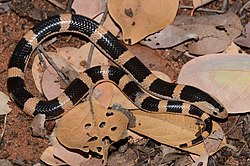Biology:Elapsoidea sundevallii
| Elapsoidea sundevallii | |
|---|---|

| |
| Scientific classification | |
| Domain: | Eukaryota |
| Kingdom: | Animalia |
| Phylum: | Chordata |
| Class: | Reptilia |
| Order: | Squamata |
| Suborder: | Serpentes |
| Family: | Elapidae |
| Genus: | Elapsoidea |
| Species: | E. sundevallii
|
| Binomial name | |
| Elapsoidea sundevallii (A. Smith, 1848)
| |
| Synonyms[1] | |
| |
Elapsoidea sundevallii, also known commonly as Sundevall's garter snake or African garter snake, is a species of venomous snake in the family Elapidae. The species is native to Southern Africa.[2][1] There are five recognised subspecies.[1]
Etymology
The specific epithet, sundevalli, honours Swedish zoologist Carl Jakob Sundevall (1801–1875).[1][3]
The subspecific name, decosteri, is in honour of Belgian consul Juste De Coster, who collected natural history specimens at Delagoa Bay, Mozambique.[3]
The subspecific name, fitzsimonsi, is in honour of South African herpetologist Vivian Frederick Maynard FitzSimons.[3]
Geographic range
E. sundevallii is found in Botswana, Eswatini, Mozambique, Namibia, South Africa , and Zimbabwe.[2][1]
Habitat
The preferred natural habitats of E. sundevallii are grassland, shrubland, savanna, and forest, at altitudes from sea level to 1,800 m (5,900 ft).[2]
Description
Adults of E. sundevallii are slate-grey to black or dark brown on the upper body, with whitish to pinkish bellies. Juveniles are banded.[1]
Males grow to be longer than females. The maximum recorded snout-to-vent length (SVL) for a male is 93 cm (37 in). The maximum recorded SVL for a female is only 65 cm (26 in).[4]
Diet
E. sundevallii preys upon frogs, lizards and their eggs, snakes, moles, and rodents.[4]
Venom
Although E. sundevallii is venomous and can inflict a serious bite, few bites have been recorded, and none has resulted in a human fatality. Symptoms may include pain and swelling, nausea and vomiting, blurred vision, and loss of consciousness.[4]
Reproduction
The species E. sundevallii is oviparous.[1] A sexually mature female may lay a clutch of as many as 10 eggs.[4]
Subspecies
The following five subspecies, including the nominotypical subspecies, are recognised as being valid.[1]
- Elapsoidea sundevallii decosteri Boulenger, 1888
- Elapsoidea sundevallii fitzsimonsi Loveridge, 1944
- Elapsoidea sundevallii longicauda Broadley, 1971
- Elapsoidea sundevallii media Broadley, 1971
- Elapsoidea sundevallii sundevallii (A. Smith, 1848)
Nota bene: A trinomial authority in parentheses indicates that the subspecies was originally described in a genus other than Elapsoidea.
References
- ↑ 1.0 1.1 1.2 1.3 1.4 1.5 1.6 1.7 Elapsoidea sundevallii at the Reptarium.cz Reptile Database. Accessed 22 August 2022.
- ↑ 2.0 2.1 2.2 Cite error: Invalid
<ref>tag; no text was provided for refs namedIUCN - ↑ 3.0 3.1 3.2 Beolens, Bo; Watkins, Michael; Grayson, Michael (2011). The Eponym Dictionary of Reptiles. Baltimore: Johns Hopkins University Press. xiii + 296 pp. ISBN:978-1-4214-0135-5. (Elapsoidea sundevallii decosteri, p. 67; Elapsoidea sundevallii fitzsimonsi, p. 91; "Elapsoidea sundevalli [sic]", p. 258).
- ↑ 4.0 4.1 4.2 4.3 Branch, Bill (2004). Field Guide to Snakes and other Reptiles of Southern Africa. Third Revised edition, Second impression. Sanibel Island, Florida: Ralph Curtis Books. 399 pp. ISBN:0-88359-042-5. ("Elapsoidea sunderwallii [sic]", p. 106 + Plates 21, 32, 37).
Further reading
- Boulenger GA (1888). "On new or little-known South-African Reptiles". Annals and Magazine of Natural History, Sixth Series 2: 136–141. (Elapsoidea decosteri, new species, p. 141).
- Boulenger GA (1896). Catalogue of the Snakes in the British Museum (Natural History). Volume III. Containing the Colubridæ (Opisthoglyphæ and Proteroglyphæ) .... London: Trustees of the British Museum (Natural History). (Taylor and Francis, printers). xiv + 727 pp. + Plates I–XXV. (Elapechis sundevallii, new combination, pp. 360–361).
- Broadley DG (1971). "A revision of the African snake genus Elapsoidea Bocage (Elapidae)". Occasional Papers of the National Museum of Southern Rhodesia 32: 577–626. (Elapsoidea sundevallii longicauda, new subspecies; Elapsoidea sundevallii media, new subspecies).
- Loveridge A (1944). "Further revisions of African Snake Genera". Bulletin of the Museum of Comparative Zoölogy at Harvard College 95 (2): 121–247. (Elapsoidea sundevalli fitzsimonsi, new subspecies, pp. 229–231).
- Smith A (1848). Illustrations of the Zoology of South Africa; Consisting Chiefly of Descriptions and Figures of the Objects of Natural History Collected during an Expedition into the Interior of South Africa, in the Years 1834, 1835, and 1836; Fitted out by "The Cape of Good Hope Association for the Exploring Central Africa:" Together with a Summary of African Zoology, and an Inquiry into the Geographical Ranges of Species in that Quarter of the Globe. [Volume III. Reptilia.] London: Lords Commissioners of Her Majesty's Treasury. (Smith, Elder and Co., printers). Plates + unnumbered pages of text. (Elaps sunderwallii, new species, Plate 56). (in English and Latin).
Wikidata ☰ Q3016942 entry
 |


